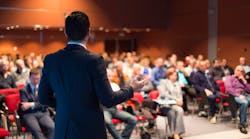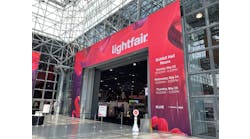The world’s annual architectural and commercial lighting trade show, Lightfair 2019, is fast approaching, but you still have time to make arrangements. Entering its 30th year, this event will be held May 19-23 at the Pennsylvania Convention Center in Philadelphia. Featuring approximately 200 hours of accredited courses spread out over five days, Lightfair offers attendees a multitude of choices when it comes to education and learning. With more than 75 courses and 140 speakers, one-day courses, two-day courses and three-hour workshops are available in a customized format via different packages or a la cart sessions. After carefully reviewing the full conference program, the following courses caught the eyes of the EC&M and Electrical Wholesaling editors.
Tuesday, May 21
The NEW Zhaga – Future-Proof Luminaires Through Interoperability
11:30 am – 12:15 pm
Presented by ZHAGA CONSORTIUM, this is a special networking event.
Visualizing Innovations in Daylight Modeling
2-3 pm
By Kevin Van Den Wymelenberg , University of Oregon, Daniel Glaser, LightStanza, Tim Metcalfe, EXTECH/Exterior Technologies, Inc., and Matthew Tanteri, HLB Lighting Design
Why is daylight analysis relevant in an electrical lighting context? Four experts explore this question, and offer unique perspectives on innovations in daylight modeling, sharing insights and practical advice in four visionary talks on how daylight modeling will change how lighting is conceptualized and executed in buildings. Beginning with intuitive representations of light, speakers discuss key elements for modeling sunlight when analyzing a building. Topics include radical concepts in daylight metrics, glare, big data, dynamic blinds/glass, and circadian rhythm.
Winning the VE Game: How to Navigate the Strong Currents of Value Engineering
2-3 pm
By Randy Burkett, Randy Burkett Lighting Design, Inc., and Dean Brockob, Modern Forms Lighting
The value engineering process is often the most painful and least satisfying aspect of lighting design. Nobody knows that more than the lighting professional. This session will explore VE and how it influences the lighting industry at many levels. The sessions will answer questions such as: Does the owner get what he/she pays for in lighting quality? How do lighting professionals make the true value of design tangible to the client? How do specifiers combat unreasonable VE options in a convincing manner? And who really benefits from VE?
Wednesday, May 22
Two forums will take place all day on Wednesday, so stop by any time to catch one of the exclusive forum discussions.
IoT & Connected Lighting Forum
The replacement of today’s lighting infrastructure with LED products offers the potential for future connected lighting systems where each luminaire becomes a point of intelligence that can share information on occupancy, activity patterns, changes in temperature or humidity, and daylight levels, as well as integrating wireless communications into the lighting system. This forum addresses the IoT and connected lighting through a suggested design guide, a field study, establishing reliable IT networks through smart lighting infrastructure, and using visible light through LiFi to carry data and information. It also addresses smart streetlights and how one can create a master plan for connected cities.
Light & Health Forum
Light has been shown to impact humans well beyond providing for optimal visual performance. This forum continues to explore the non-visual effects of light on humans – including addressing whether the cones play a larger role in circadian response; optimizing human physiology through tunable lighting and whether tunable lighting for health is a fad or the future of lighting design; some new recommendations for circadian entrainment; and addressing the WELL building standard provisions using daylighting and controls. The forum culminates with in an exploration of the non- visual effects of lighting for educational facilities.
Game Changer: The Evolution of the Lighting Model behind ASHRAE 90.1
8:30 am – 10 am
By Marty Salzberg, Retired, Kelly Seeger, Signify, Mark Lien, Illuminating Engineering Society, and Michael Myer, Pacific Northwest National LaboratorySince its creation in the 1990s, the lighting model in Standard 90.1 has been the primary methodology for setting energy consumption limits for lighting systems in the U.S. energy codes. While the model has been updated with each new version of the Standard, there has never been a wholesale review and reconstruction of the model until now. This knowledgeable panel will showcase the comprehensive consensus approach taken, explain the lighting guidance, calculations, inputs, and considerations underpinning the new model, and review insights from the lighting design field validation conducted for the new model. The session will conclude with a discussion on the future of lighting efficiency, compliance metrics, and new considerations for 90.1
Thursday, May 23
What's Next with Energy Codes?
8:30 am – 10 am
By Harold Jepsen, Legrand, and Gina Rodda, Gabel Energy2018 was a busy year in the world of commercial building codes and there is more in store for 2019. Several cities like Philadelphia, and states including Wisconsin, Pennsylvania, Connecticut, and Florida are adopting updated building codes on energy standards and lighting controls. This presentation will explore these upcoming lighting control requirements and changes. It will also provide recommendations to help you simplify controls to achieve code compliance while making the most of controls investments beyond compliance.
This is just a sampling of the educational sessions available, so check the full conference schedule for the latest in education and innovation showcasing the future of light, technology, design and connectivity.



